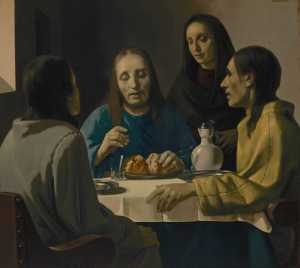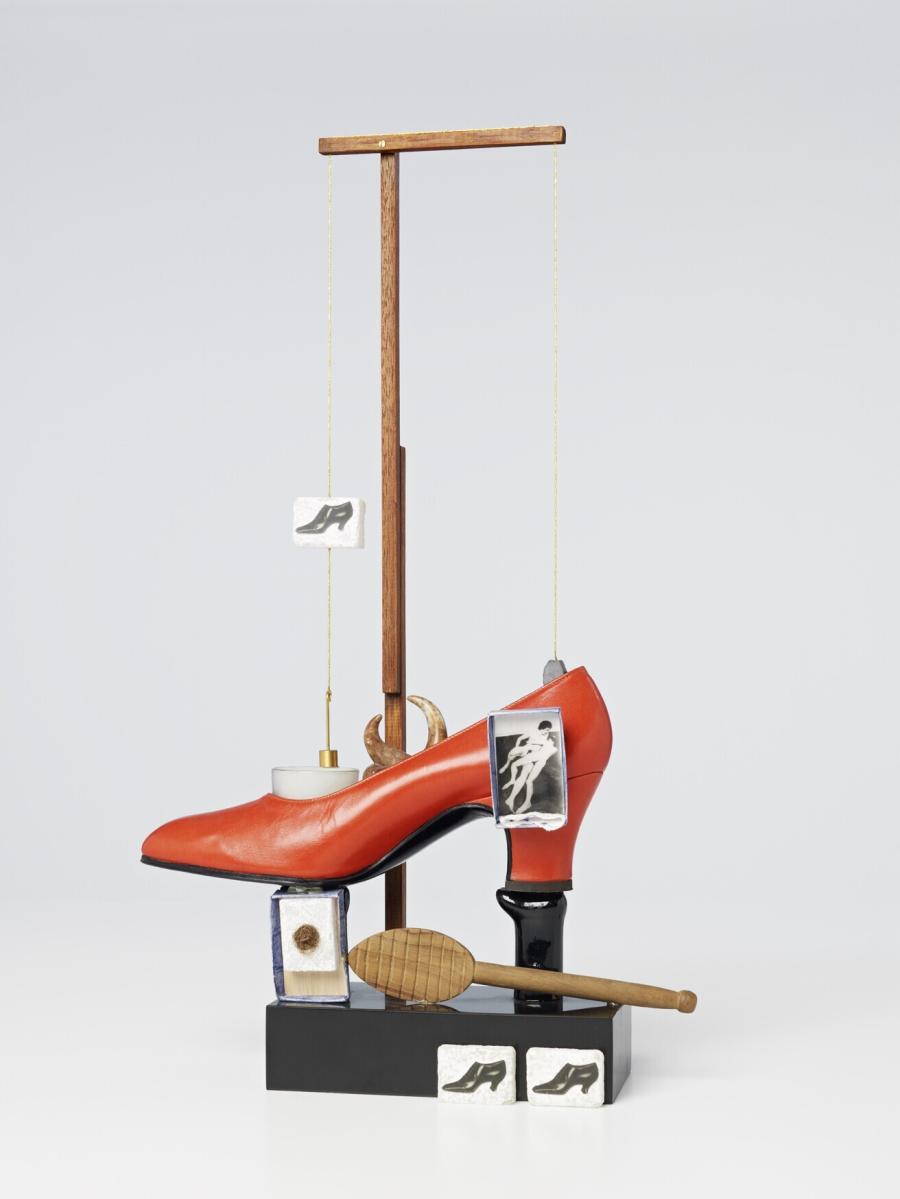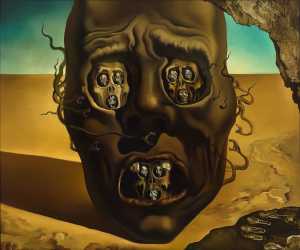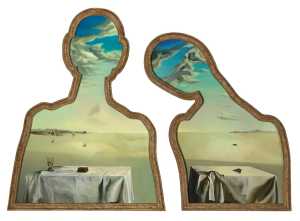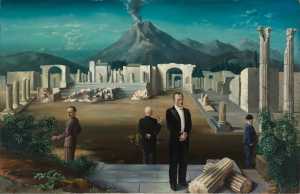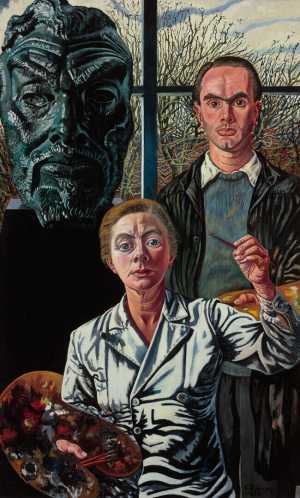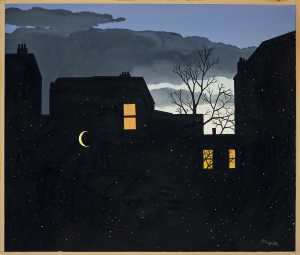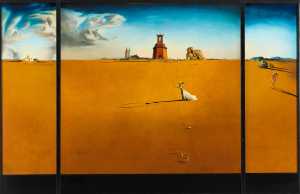This object was illustrated in the journal 'Le surréalisme au service de la Révolution' in 1930. Thereafter it was lost. Dalí made the reconstruction shown here in 1973. It is a mysterious object comprising a small shoe, a glass of milk, sugar cubes, a box of matches and pubic hair.

Specifications
| Title | Objet scatologique à fonctionnement symbolique |
|---|---|
| Material and technique | Wood, shoe, cardboard, plaster, fabric, hair, marble, glass, candlewax, brass, lead, gold thread and gelatin silver print on fibre-based paper |
| Object type |
Assemblage
> Three-dimensional object
> Art object
|
| Location | This object is in storage |
| Dimensions |
Width 24 cm Height 48 cm Depth 14 cm |
|---|---|
| Artists |
Artist:
Salvador Dalí
|
| Accession number | BEK 1714 a-c (MK) |
| Credits | Purchased with the support of Stichting Museum Boijmans Van Beuningen, 2001 |
| Department | Modern Art |
| Acquisition date | 2001 |
| Creation date | in 1931 (1973) |
| Entitled parties | © Salvador Dalí, Fundación Gala-Salvador Dalí, c/o Pictoright Amsterdam 2022 |
| Provenance | Max Clarac-Sérou, Paris; The Mayor Gallery, London |
| Exhibitions | Humlebaek 1973; Stockholm 1974; Nuremburg 1976; London 1978; Paris 1978-79; Stuttgart/Zurich/Humlebaek 1989-90; Paris/Madrid 1991; Paris 1995-96; London/New York 2001-02; Venice/Philadelphia 2004-05; Rotterdam 2005a; Rotterdam 2017b |
| Internal exhibitions |
De collectie als tijdmachine (2017) Collectie - surrealisme (2017) |
| External exhibitions |
De tranen van Eros - Moesman, surrealisme en de Seksen (2020) |
| Research |
Show research Digitising Contemporary Art Show research A dream collection - Surrealism in Museum Boijmans Van Beuningen |
| Literature | Paris 1979, p. 219, fig. 155; Ades 1982, p. 154; London/New York 2001-02, p. 35, fig. 21; Rotterdam/Barcelona/Madrid 2005, p. 230; Rotterdam 2007, pp. 19, 68-69; Frankfurt 2011, pp. 22, 28, 227-28; Paris/Madrid 2012-13, p. 182 |
| Material |
Marble
> Metamorphic stone
> Stone
> Minerals and stones
> Inorganic material
> Material
> Material and technique
Gold thread
> Gold
> Precious metal
> Metal
> Inorganic material
> Material
> Material and technique
|
| Object | |
| Technique |
Gelatine silver print
> Bromide print
> Photographic printing technique
> Mechanical
> Planographic printing
> Printing technique
> Technique
> Material and technique
|
Do you have corrections or additional information about this work? Please, send us a message
Entry catalogue Digitising Contemporary Art, A dream collection - Surrealism in Museum Boijmans Van Beuningen
Author: Marijke Peyser
In 1929 André Breton welcomed the Spanish artist Salvador Dalí into the Surrealist movement and Dalí moved from his birthplace of Figueres to Paris. In the same year he made the film Un chien andalou with Louis Buñuel. In the second Surrealist Manifesto, Breton praised Dalí for his dealings with the subconscious. At the end of the 1920s there was conflict within the movement about whether or not to merge with the Communists. Various suggestions were aired about keeping the group together including a proposal by Dalí to make Surrealist objects. In December 1931 he published ‘Objets surréalistes’ in the magazine Le Surréalisme au service de la révolution.[1] In it he described Objet scatologique à fonctionnement symbolique of 1931 – the version in Museum Boijmans Van Beuningen’s collection is a later edition dating from 1973. Dalí classified the object in the group he called Objets à fonctionnement symbolique: ‘These objects, which at the very least lend themselves to mechanical operation, are derived from hallucinations and depictions that may arise out of actions of which one is unaware.’[2] Dalí called his other categories Objets transsubstanciés, Objets à projeter, Objets enveloppés, Objets-machines en Objets-moulages (Transubstantiated Objects, Objects to be thrown, Wrapped Objects, Machine Objects and Mould Objects).
In his Surrealist objects Dalí endorsed Sigmund Freud’s definition of fetishism: they should satisfy the suppressed – often sexual – desires of the viewer.[3] The parts of Dalí’s assembly Objet scatologique à fonctionnement symbolique are illustrative objects that arouse feelings of lust in fetishists. The sense of pleasure is shifted from the loved one to a component, a symbol or an item of clothing. Dalí added a pornographic photograph, pubic hair and a fake turd to emphasize the sexual context.
At first, Surrealist artists did not make sculptures and objects. The earliest date from 1930, with Giacometti’s Boule suspendue as one of the first examples. This was because making a sculpture or a work assembled from found objects took time. It seemed hard to reconcile this with the desire to express the irrational, the subconscious and dreams. Nevertheless, it is impossible today to imagine the absurdist repertory of the Surrealists without objects. Boule suspendue consists of a ball with a split hanging on a string above an object with a sharp edge. The ball does not come into contact with the sharp object, but can easily be set in motion. Dalí was not the only one who admired Giacometti’s object; it caused a sensation among the Surrealists.[4] In the 1930s artists like Meret Oppenheim, Marcel Jean, Oscar Domínguez, Roland Penrose and Eileen Agar also made Surrealist objects. In his autobiography Dalí related how he devoted himself to the promotion of the Surrealist object with an erotic overtone that could also be made and manipulated by everyone.[5]
All about the artist
Salvador Dalí
Figueras 1904 - Figueras 1989
Salvador Dali got to know the author André Breton - the founder of the surrealist movement - while he was studying in Madrid. In 1924, Breton wrote the first...
Bekijk het volledige profiel


